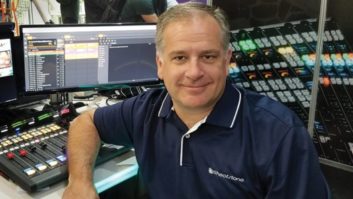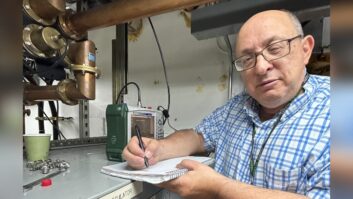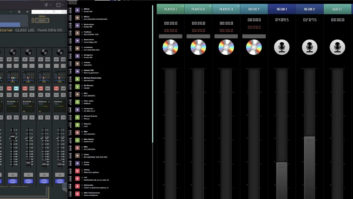 It’s doubtful that any of the major radio broadcast groups in the United States included a pandemic on the list of emergencies they worried about when creating preparedness plans. Yet the coronavirus outbreak quickly demanded changes in operations at most stations.
It’s doubtful that any of the major radio broadcast groups in the United States included a pandemic on the list of emergencies they worried about when creating preparedness plans. Yet the coronavirus outbreak quickly demanded changes in operations at most stations.
The solutions that broadcasters have adopted are likely to have long-term implications. Managers say these new workflows will influence how stations operate after the pandemic ends.
Better Than Imagined
Maintaining critical infrastructure during the emergency, while coping with staff cuts, furloughs and medical absences, certainly challenged engineering leaders. Most broadcast groups also froze capital expenditure spending and placed numerous projects on hold.
One chief technology officer told Radio World his company’s build-out projects were “paused but not cancelled” pending a recovery.
The use of remote technology for air staff accelerated early in the crisis as broadcasters faced social distancing guidelines and stay-at-home orders.
One veteran broadcast engineer said in some cases, “Entire air staffs at radio stations are working from home, and working better than anyone imagined,” which leads him to believe “these short-term fixes could turn into long-term strategies.”
The versatility of the cloud also is being stretched in new ways, including ingesting production remotely through virtual private network capacity.
“This was like having a day or two to plan for a hurricane, since some studios were emptied out the same day a staff member tested positive for COVID-19,” said a corporate engineer. “We were mapping major technical changes that had to happen within 24 hours in many cases. It got ‘real’ really fast.”
Another engineering executive said it was “like going from 100 on-air studios to 4,000 home studios,” all with the same network security concerns. Most broadcasters established VPN or other remote access protocols for employees to connect to station servers from home.
[Read “How to Choose Your Next Radio Console”]
Gaps in cybersecurity became a major focus of radio technical staffs worried that audio feeds could be hijacked from home computers protected by less-robust security systems, according to several engineers.
“Our first focus was getting everyone out of our buildings,” one said. “Beginning with sales then programming. Then you’re faced with moving the air staff to at home work and that’s the heavy lift, especially with live shows. Fortunately we can voicetrack the music stations. Everyone was VPNing in from distance. In some cases people just yanked the desktop from their work desk and took it home.”
It was a big job for many broadcasters. In Washington, WAMU Director of Technology Rob Bertrand said that by late April, “We finally got everyone out of the building. Hosts, producers, engineers, call screeners, editors, reporters … from national talk shows to regional podcasts … all from home,” he wrote in an email. “It’s been great to be able to breathe a sigh of relief that everyone is safe and we are able to keep going while the dust settles around the question of when and how to reopen everything.”
Video Conference Tools
Video conferencing is the new norm, and remote broadcasting from home studios has become routine for many broadcasters.
“The Bert Show,” a syndicated morning show distributed by Westwood One, used BlueJeans video conferencing to bring members of the morning show together on air.
At least one broadcaster utilized StreamYard, a live streaming studio app, to allow for the simultaneous stream distribution of remote content to YouTube, Twitch, LinkedIn and Facebook, which they hoped would stimulate listener engagement.
Mike Cooney, CTO and executive VP of engineering for Beasley Broadcasting, said the company’s immediate focus was getting everyone home, especially in clusters with employees that tested positive for COVID-19.
“The transition to home was fairly smooth. I would say probably better than I could have hoped. We have a lot of people working on their home computers, so we had to implement a lot of security changes and installed a lot of VPNs,” Cooney said.
Beasley was not immune to the job cuts that have affected many companies. It eliminated 67 positions, including five broadcast engineers, in early April, according to a company announcement. That included one “corporate-level IT person,” Cooney said.
Operations at stations have continued without much interruption, Cooney said, even though the overall “on-air sound at times hasn’t been totally smooth.”
Beasley utilized remote gear “from some of our largest sports stations currently not being used” to supply some air staff with home studio equipment, Cooney said. “We did purchase about 10 additional Comrex units for air staff to use from home,” he said.
Cooney said that in the future he expects to see more “reciprocal agreements” among radio competitors within markets, to work together during a crisis.
“I think radio needs to stop competing against each other during a crisis like this pandemic. The landscape changes when things like this happen. I see a day when resources are shared, and that maybe even means sharing studios. It could bring some further consolidation, but groups could share generators, towers and maybe even engineering staff. But radio stations could still compete,” he said.
“I see a few things coming out of this — a more collaborative environment between radio groups, more shared workspace for employees and many more staff working from home.”
“Radio needs to stop competing against each other during a crisis like this pandemic. The landscape changes when things like this happen.”
— Mike Cooney
Cooney chairs the NAB’s Technology Committee and says the developments lend urgency to the group’s work dealing with the cloud.
“We have spent a lot of time focused on the ability for broadcasters to do more in the cloud, and looking at EAS and PPM encoding. We know you can do automation and processing in the cloud, but we think being able to remote control EAS and PPM encoding is a logical step,” Cooney said. “It would give a broadcaster the ability to easily run a broadcast facility from another market during an emergency.”
A More Remote Workforce
Jason Ornellas, director of engineering at Bonneville International, said even though engineers typically look for “solutions and answers, it’s hard to imagine such a scenario” as a pandemic.
Bonneville, which owns 21 stations in six markets in the U.S., quickly transitioned all employees in administration, sales, marketing and digital to remote work through VPN and Microsoft 365 in the cloud.
“We ordered remote home studio broadcast kits to make the home studio as turnkey as possible for our on-air talent’s convenience to make them feel comfortable and safe from their home. Tutorial videos were produced to show unpacking and setting up the equipment as well as using RCS Zetta2Go,” he said. “The file servers are providing everyone with a sense of being on the network from home.”
The home studio kits included an EV RE320 microphone with stand, XLR cables, RodeCaster Pro Board, Tascam headphones and Comrex BRIC Link II. (The Sacramento cluster is one of the case studies featured in Radio World’s “Broadcasting From Home” webcast series.)
Bonneville said in a press release in April it did not anticipate staff cuts. Ornellas said technical staff is needed now more than ever.
“I think long term you will see a lot more remote workforce. When we rebound, which I believe radio and audio will, virtualization, software-based solutions and cloud initiatives will be the forefront. Our vendors recognize that,” Ornellas said. “There is nothing like a real emergency to get things moving in a creative way. Some of our technical priorities have changed.”
Some industry observers expect there will be newly discovered cost savings and efficiencies as a result of the new virtualization adopted by broadcasters, which corporate owners might be anxious to implement.
“When we rebound — which I believe radio and audio will — virtualization, software-based solutions and cloud initiatives will be the forefront.”
— Jason Ornellas
“This crisis is likely to change the way we think about every single radio position in the building, including sales and programming. It is likely owners and managers will take a hard look at what lessons we learned,” said one corporate technical employee.
Remote work in general “will likely increase for broadcasters because everyone is going to be accustomed to a new normal,” another engineer said
“This pandemic has forced everyone to think about how they do their jobs. Everything has been hyper-focused right now on how to do things as efficiently as possible and I think some of that will hold over once this is over,” he said. “So the first step is getting through this crisis and then putting everything back together.”
Bertrand of WAMU said, “It was remarkable, while working to transition the live products of our talk show teams and local hosts to their homes, to walk through a fully vacant newsroom and then hear a record volume of content on the air and see it on our websites. It does make me wonder if we might adopt a more distributed work model for our journalists in the long term.”
He said WAMU grappled with questions about how, why and when to deploy automation functions, but decided that emergencies are when a live and local voice is more important than ever to its audience. “Even if that voice is simply checking in between network elements, they are a reassuring companion for so many people who are seeking a foothold in this time of crisis.”
For WAMU’s complex national and local talk shows, he said it was a feat to move to 100% remote production, but he doesn’t foresee that being a new normal.
“Similarly, we have now proven that complex live newscasts are possible from home; and while this model might be helpful in storm responses in the future, it has also been challenging. I’m not sure that we would attempt to permanently distribute our entire journalism operation to quite the extent that has happened; but we have proven that it is possible,” Bertrand said.
“It does make you start to think about the cost of real estate per square foot, versus the alternatives. My dream is that this opens up new collaborative opportunities across the public media ecosystem; that we might all be stronger together in the aftermath of this pandemic.”
How do you think our industry and its technical workflows will change in the long term due to the coronavirus crisis? Email [email protected] with “Letter to the Editor” in the subject field.







